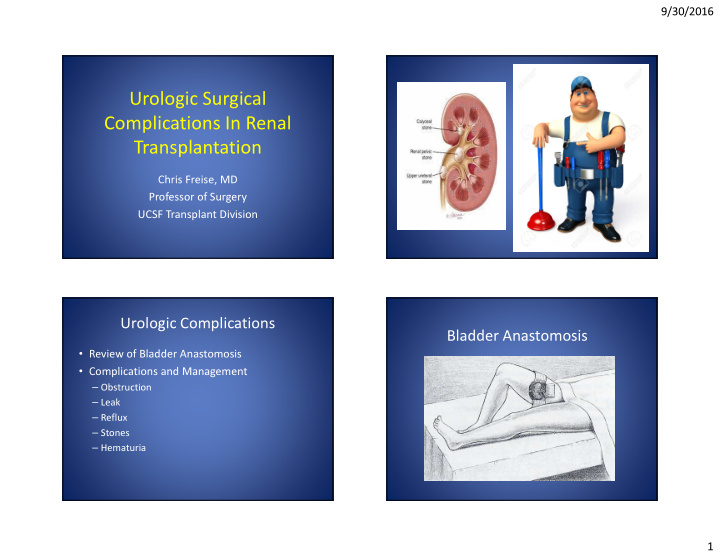



9/30/2016 Urologic Surgical Complications In Renal Transplantation Chris Freise, MD Professor of Surgery UCSF Transplant Division Urologic Complications Bladder Anastomosis • Review of Bladder Anastomosis • Complications and Management – Obstruction – Leak – Reflux – Stones – Hematuria 1
9/30/2016 2
9/30/2016 Obstruction Complications by Technique Blockage of urine flow along urinary tract. Can occur at level of renal pelvis (UPJ) or at bladder anastomosis (UVJ) Signs/symptoms include rise in creatinine, drop in urine output. Treatment options depend on whether early (<6 months) or late after transplant. Case 1 Case 1 57 yof, ESRD from GN, received living donor transplant, Biopsy not done. extravascular bladder anastomosis without stent. Patient sent to Interventional Radiology for percutaneous Initial good function, with drop in creatinine to 1.4, D/C antegrade pyelogram on POD 3, Foley out. Obstruction at UVJ, nephrostomy tube left in Seen in clinic, POD 10, Cr up to 1.8 Admitted for biopsy, moderate hydronephrosis noted on ultrasound. 3
9/30/2016 Case 1 Discharged, follow-up creatinine rose to 2.8, but gradually fell to 2.1 Returned for stent placement, nephrostomy tube capped Will have stent removal at six weeks, may need biopsy if creatinine does not fall to baseline (1.3) 1 Early UVJ Obstruction Managed initially with stent, removed at six weeks with follow-up creatinine after stent removal. Nephrostomy left in place but capped If follow up Cr rises- nephrostomy tube opened and definitive surgery scheduled If follow up Cr stable-nephrostomy tube removed 2 4
9/30/2016 Early UVJ Obstruction Early Obstruction Above UVJ Etiology of UVJ obstruction: Etiology: Poor surgical technique More extensive ischemia Tunnel too tight Twist in ureter Ischemia of distal ureter Compression by vessels Edema at anastomosis (most common) Compression by lymphocoele Usually will require surgical fix Case 2 48 yom, ESRD from PCKD, deceased donor transplant 4 years ago. Slow rise in creatinine from 1.8 to 2.4 Admitted for biopsy Ultrasound reveals hydroureter, biopsy aborted Interventional radiology for antegrade pyelogram. 1 5
9/30/2016 Case 2 Longer segment narrowing found with slow drainage into bladder. Dilated, nephroureteral tube placed. 2 Case 2 Creatinine returned to baseline Since obstruction > 6 months, option of surgery discussed. Patient is not an optimal candidate, will try repeat dilation with 6 weeks of stent. If fails (likely), then surgical repair 3 6
9/30/2016 Late Obstruction Options for Surgical Repair Etiology: Reimplant ureter– requires adequate length of healthy ureter Ischemia of ureter Stones Fungus ball Uretero-ureterostomy- to ipsilateral native ureter or rarely to contralateral ureter Tumor Polyoma virus Mobilization of bladder for psoas hitch or Boari flap Lymphocoele Surgical repair generally needed, lifelong stent for Pyelovesicostomy if no useable ureter nonsurgical candidates 7
9/30/2016 Lymphocoele Lymphocoele 2-5% of transplants, may be asymptomatic Aspiration to near collapse of cavity occasionally successful Obstruction of ureter, compression of iliac vein or wound complications are possible clinical features Most commonly peritoneal window for drainage is needed, often done laparoscopically Aspiration of fluid, high lymphocyte count is diagnostic If window not possible, aspiration with introduction of sclerosing agent may be successful. 8
9/30/2016 Urine Leak Most commonly occurs early post-tx, usually detected when Foley removed Hallmarks are severe pain, wound drainage, drop in urine output Diagnosis confirmed by MAG 3 study showing extravasation of contrast 9
9/30/2016 Role of Stents To Prevent Urine Leak Obstruction/Leak Etiology: • Cochrane Review: Routine stenting decreases early Poor technique with gaps in suture line urologic complications by 24% • Downside is increased incidence of UTI, cost of stent Ischemia of distal ureter with necrosis of tissue and removal Unrecognized damage to ureter or bladder • Selective use has not been well studied • Potential indications: Immediate treatment involves replacement Foley, – Small ureter – Complex ureter anatomy followed by definitive surgical repair (reimplant ureter or – Extrarenal pelvis uretero-ureterostomy) – Large kidney High rate of success with repair Case 3 Case 3 56 yof, ESRD from IgA nephropathy, deceased donor Ultrasound negative for stones, debris transplant 6 years ago with Cr 0.8 VCUG to assess bladder emptying and presence of reflux Recurrent pyelonephritis, up to monthly infections Failed conservative management (double voids, suppressive antibiotics, methenamine, cranberry tablets) Developing resistance to antibiotics 10
9/30/2016 1 2 Stone disease Reflux Need to rule out infection in native kidneys (selective • May be de-novo or “gifted” sampling of urine from transplant and native kidneys) • If mobile stone detected in donor, can attempt removal on back table before kidney Rule out bladder stones, suture in bladder implanted. • Presentation of stone disease may be with Need to confirm that bladder emptying is adequate infection or obstruction, usually painless Reflux common despite anti-reflux tunnel Surgical management involves ureter reimplantation with new tunnel or uretero-ureterostomy. 11
9/30/2016 Stone disease: Therapy Hematuria Common immediately post-transplant, related to • Percutaneous retrieval of large stones (>1.5 bleeding from bladder anastomosis cm) • Shock wave lithotripsy may be needed Usually self limited, bladder irrigation to prevent • Smaller stones extracted with ureteroscope if obstruction of Foley. transplant ureter orifice can be cannulated If hematuria develops POD 2-3, ultrasound to rule out venous thrombosis 12
9/30/2016 Hematuria Conclusions Late hematuria: May be related to biopsy, Management of urologic complications post-tx often If persistent, angiography needed to evaluate for complex, requires multidisciplinary approach arterial fistula Evaluate for malignancy, in transplant ,native Management (and etiology) varies depending on time kidneys, or bladder post-transplant Polyoma virus or adenovirus Cooperation of transplant surgeons and urologists often “Forgotten” stent beneficial Failed kidney: Transplant Nephrectomy Conclusions Surgical Plumbers don’t charge triple overtime on weekends and holidays!! 13
Recommend
More recommend